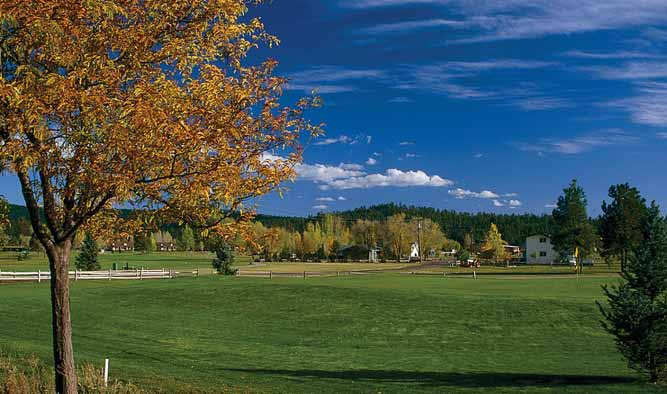BACK ROAD ADVENTURE

{back road adventure} Travel Old West Ranch Country from Munds Park to Mormon Lake
TROLLING ALONG the wooden sidewalk that connects Mormon Lake Lodge and Steakhouse, the post office and general store, I could almost hear the jingle of a cowboy's spurs.
In the 1800s, Mormon settlers introduced sheep and cattle ranching to northern Arizona. Lot Smith, one of the early settlers, built the first sawmill for the fledgling logging industry. The abundance of timber to be cut eventually brought many loggers and their families. When the A & P Rail lines came through in 1887, Mormon Lake Village prospered as a hub for shipping logs, railroad ties and fuel.
The quick-and-easy way to reach Mormon Lake, 30 miles southeast of Flagstaff, is paved Lake Mary Road (Forest Service Road 3) off Interstate 17. This route offers plenty of scenery as it passes through a forest of ponderosa pine, oak and aspen trees, but I wanted to nurture my adventurous spirit and chose the less-traveled roads to the lake, hoping for a glimpse of elk, deer or wild turkey.
The morning dawned bright and clear as my husband, Lloyd, and I traveled north from Phoenix on Interstate 17 to begin our drive from Munds Park through Coconino National Forest to Mormon Lake. We took Exit 322-where we began our mileage count-at Munds Park and turned right at the end of the off ramp to drive east on Pinewood Boulevard.
The paved road runs through Munds Park, a mountain community comprised mostly of summer homes. Upon leaving Munds Park, we crossed a cattle guard at 1.8 miles where Pinewood Boulevard gives way to Forest Service Road 240. We remained on the well-marked FR 240 the entire 14.6-mile drive to our destination. The first 5 miles of the road were well maintained, graveled and smoothly graded. Traveling in an easterly direction, we passed through a rich wildlife habitat and ideal spots for camping, hiking and picnicking.
As we gradually gained altitude, towering ponderosa pines, oaks and aspens became a backdrop to meadows green from the summer rains. We continued to follow 240, and at 3.9 miles, crossed a narrow bridge over a spring-fed stream running into the meadow where elk and deer come out from their sanctuary of trees to feed and drink at early dawn and dusk.
[BELOW] Jennifer Gold's smile and a steak-and-bean dinner brighten the entrance to the Mormon Lake Lodge Steakhouse. [BELOW RIGHT] Reminiscent of the community's pioneer beginnings, a horse-drawn wagon welcomes visitors to the village of Mormon Lake's southern entrance. [BOTTOM] Speckled with yellow foliage, a stand of Gambel oaks interrupts a meadow near the junction of FR 240 and Mormon Lake Road.
In spite of the drier than usual conditions, the stock tanks were almost full of water for the cattle. Elk, wild turkey and deer are abundant in this region, although on this particular day we saw only squirrels scampering about, playing tag from tree to tree.
Ranch houses at the edge of the forest are a reminder that we're in historic ranching country, where cattle graze in the meadows as they have for more than a century.
After 6.6 miles from our turnoff onto Pinewood Boulevard, 240 yields a sharp bend to the left and we begin a climb to above 7,000 feet in elevation. White billowing clouds forming against the clear blue skies appeared to be close enough to reach up and touch. Less than a mile from the start of the climb, a junction with Forest Service Road 700 heading north offered another adventure, but on this trip, we decided to maintain our course eastward on 240.
As we drove past Forest Service Road 91, our route climbed steeply and soon narrowed and became washboardy. Using caution, this road is suitable for a passenger car. Unlike many Arizona back roads, the route doesn't involve switchbacks, which allows an opportunity to relax and savor the solitude and beauty of the forest. Through an opening in the trees, we eventually could see Mormon Lake Valley below. An intersection with Forest Service Road 90 terminates 240, and we turned right, driving southeast on the two-lane paved road for the remaining 3 miles to Mormon Lake Village.
The village affords a trip back to the days of sheep and cattle ranching, far away from traffic lights, fast-food outlets and city noise. A welcome sign at the edge of town announces a population of 50 to 5,000, depending on the season. Surrounded by Coconino National Forest, the Western village stands at the edge of what once was the state's largest natural lake.
Scott Gold, general manager of the Mormon Lake Lodge, explained that the lake exists because a natural dam created by volcanic eruptions holds rainfall and seasonal runoff in a depression formed by cattle and sheep trampling the ground. On rare occasions, when full, the lake measures 5 miles long and 3 miles wide. Years of drought have taken a toll-the lake now is nearly dry.
Mormon Lake Lodge was built in 1924 at the peak of the ranching and logging days. Virtually destroyed by fire in 1974, it was rebuilt with the same rustic decor. The local ranchers, many of whom helped rebuild the lodge, seared their own brands into the rough wooden walls during what is claimed to have been the wildest branding party ever held. In 1994, the property was purchased by Forever Resorts, which maintains the Old West atmosphere that has welcomed lodge visitors for 80 years. Inside the rustic lodge, a fire in the huge native-stone fireplace emitted warmth into the far corners of the dining area of the steakhouse, which has one of the few authentic open-pit mesquite grills in Arizona. Oil lanterns
hang from the walls and red-checkered tablecloths adorn the picnic tables. Hanging overhead on a piece of driftwood, an optimistic sign reads, “Save your oars, boys, the lake will rise again.”
Already a member? Login ».